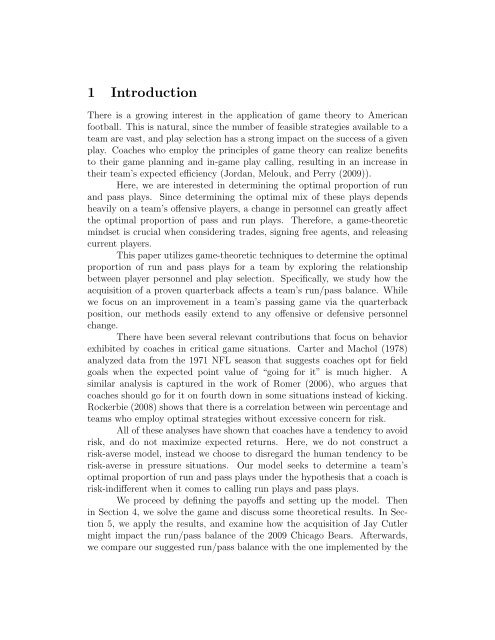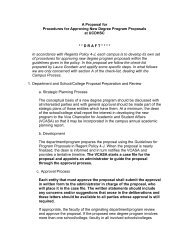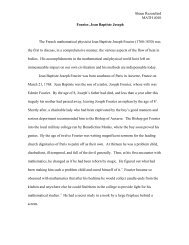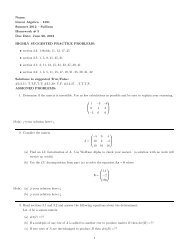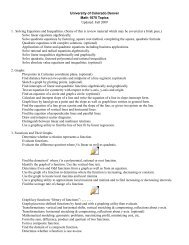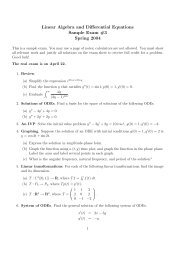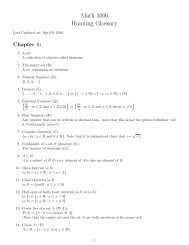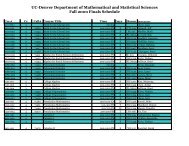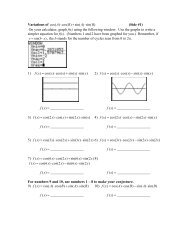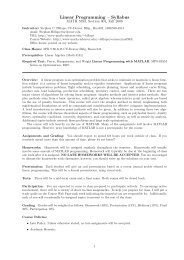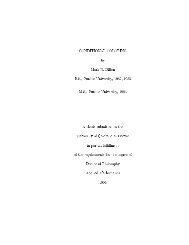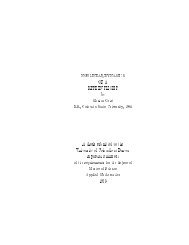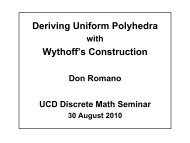A Game-Theoretic Approach to Personnel Decisions in American ...
A Game-Theoretic Approach to Personnel Decisions in American ...
A Game-Theoretic Approach to Personnel Decisions in American ...
Create successful ePaper yourself
Turn your PDF publications into a flip-book with our unique Google optimized e-Paper software.
1 Introduction<br />
There is a grow<strong>in</strong>g <strong>in</strong>terest <strong>in</strong> the application of game theory <strong>to</strong> <strong>American</strong><br />
football. This is natural, s<strong>in</strong>ce the number of feasible strategies available <strong>to</strong> a<br />
team are vast, and play selection has a strong impact on the success of a given<br />
play. Coaches who employ the pr<strong>in</strong>ciples of game theory can realize benefits<br />
<strong>to</strong> their game plann<strong>in</strong>g and <strong>in</strong>-game play call<strong>in</strong>g, result<strong>in</strong>g <strong>in</strong> an <strong>in</strong>crease <strong>in</strong><br />
their team’s expected efficiency (Jordan, Melouk, and Perry (2009)).<br />
Here, we are <strong>in</strong>terested <strong>in</strong> determ<strong>in</strong><strong>in</strong>g the optimal proportion of run<br />
and pass plays. S<strong>in</strong>ce determ<strong>in</strong><strong>in</strong>g the optimal mix of these plays depends<br />
heavily on a team’s offensive players, a change <strong>in</strong> personnel can greatly affect<br />
the optimal proportion of pass and run plays. Therefore, a game-theoretic<br />
m<strong>in</strong>dset is crucial when consider<strong>in</strong>g trades, sign<strong>in</strong>g free agents, and releas<strong>in</strong>g<br />
current players.<br />
This paper utilizes game-theoretic techniques <strong>to</strong> determ<strong>in</strong>e the optimal<br />
proportion of run and pass plays for a team by explor<strong>in</strong>g the relationship<br />
between player personnel and play selection. Specifically, we study how the<br />
acquisition of a proven quarterback affects a team’s run/pass balance. While<br />
we focus on an improvement <strong>in</strong> a team’s pass<strong>in</strong>g game via the quarterback<br />
position, our methods easily extend <strong>to</strong> any offensive or defensive personnel<br />
change.<br />
There have been several relevant contributions that focus on behavior<br />
exhibited by coaches <strong>in</strong> critical game situations. Carter and Machol (1978)<br />
analyzed data from the 1971 NFL season that suggests coaches opt for field<br />
goals when the expected po<strong>in</strong>t value of “go<strong>in</strong>g for it” is much higher. A<br />
similar analysis is captured <strong>in</strong> the work of Romer (2006), who argues that<br />
coaches should go for it on fourth down <strong>in</strong> some situations <strong>in</strong>stead of kick<strong>in</strong>g.<br />
Rockerbie (2008) shows that there is a correlation between w<strong>in</strong> percentage and<br />
teams who employ optimal strategies without excessive concern for risk.<br />
All of these analyses have shown that coaches have a tendency <strong>to</strong> avoid<br />
risk, and do not maximize expected returns. Here, we do not construct a<br />
risk-averse model, <strong>in</strong>stead we choose <strong>to</strong> disregard the human tendency <strong>to</strong> be<br />
risk-averse <strong>in</strong> pressure situations. Our model seeks <strong>to</strong> determ<strong>in</strong>e a team’s<br />
optimal proportion of run and pass plays under the hypothesis that a coach is<br />
risk-<strong>in</strong>different when it comes <strong>to</strong> call<strong>in</strong>g run plays and pass plays.<br />
We proceed by def<strong>in</strong><strong>in</strong>g the payoffs and sett<strong>in</strong>g up the model. Then<br />
<strong>in</strong> Section 4, we solve the game and discuss some theoretical results. In Section<br />
5, we apply the results, and exam<strong>in</strong>e how the acquisition of Jay Cutler<br />
might impact the run/pass balance of the 2009 Chicago Bears. Afterwards,<br />
we compare our suggested run/pass balance with the one implemented by the
Chicago Bears this past season and some implications due <strong>to</strong> this comparison.<br />
2 Sett<strong>in</strong>g Up the <strong>Game</strong><br />
We consider two-by-two zero-sum games where the offense either runs or passes<br />
and the defense either defends aga<strong>in</strong>st the run or defends aga<strong>in</strong>st the pass.<br />
Each payoff represents an expected ga<strong>in</strong> for the offense under the given strategic<br />
situation. For any serious football team, it is reasonable <strong>to</strong> suggest that<br />
the payoffs can be found, s<strong>in</strong>ce every coach<strong>in</strong>g staff spends much of their time<br />
break<strong>in</strong>g down film.<br />
Table 1: Initial Payoffs<br />
Defense<br />
Defend Run Defend Pass<br />
Offense Run ar,r ar,p<br />
Pass ap,r ap,p<br />
Let the offensive and defensive strategy sets be {R,P } and {DR,DP },<br />
respectively. Furthermore, let ar,r denote the payoff for (R,DR), ar,p denote<br />
the payoff for (R,DP), and so on, as <strong>in</strong> Table 1. Throughout this paper, we<br />
make the reasonable assumptions that ar,r < ap,r and ar,p > ap,p.<br />
We calculate the expected ga<strong>in</strong> for the offensive team <strong>in</strong> a straightforward<br />
manner, save that we adopt a convention used by Alamar (2006) and<br />
Rockerbie (2008) and deduct 45 yards from a team’s <strong>to</strong>tal yardage for each<br />
fumble and <strong>in</strong>terception. For <strong>in</strong>stance, <strong>to</strong> determ<strong>in</strong>e ar,r, suppose that there<br />
were nr,r observed plays <strong>in</strong> which the offense elected <strong>to</strong> run and the defense<br />
elected <strong>to</strong> defend the run, amount<strong>in</strong>g <strong>in</strong> a <strong>to</strong>tal of yr,r yards and tr,r turnovers.<br />
Then<br />
ar,r = yr,r − 45tr,r<br />
.<br />
The rema<strong>in</strong><strong>in</strong>g payoffs <strong>in</strong> Table 1 are calculated <strong>in</strong> a similar manner.<br />
nr,r<br />
3 The Improvement <strong>in</strong> Pass<strong>in</strong>g Model<br />
Hav<strong>in</strong>g demonstrated how <strong>to</strong> calculate the payoffs for our team prior <strong>to</strong> the<br />
relevant personnel change, we now model the impact of this personnel change
on our team’s performance. We assume that the team has acquired a proven<br />
quarterback whose presence will improve all aspects of the pass<strong>in</strong>g game. This<br />
will be reflected <strong>in</strong> our payoff table via an <strong>in</strong>crease <strong>in</strong> both payoff entries<br />
associated with an offensive pass<strong>in</strong>g play.<br />
The follow<strong>in</strong>g additional assumption is a critical part of our model. It<br />
is a common belief that the success of the pass<strong>in</strong>g game is <strong>in</strong>tertw<strong>in</strong>ed with the<br />
success of the runn<strong>in</strong>g game. Consequently, we suppose that the <strong>in</strong>crease <strong>in</strong><br />
expected ga<strong>in</strong>s through pass<strong>in</strong>g will also have a positive effect on the runn<strong>in</strong>g<br />
payoffs ar,r and ar,p. Although the quarterback will positively <strong>in</strong>fluence the<br />
runn<strong>in</strong>g game, he will have a greater impact on the pass<strong>in</strong>g game. This is<br />
because production <strong>in</strong> the pass<strong>in</strong>g game rests squarely upon his ability and<br />
performance, whereas the quarterback’s <strong>in</strong>fluence is generally limited <strong>in</strong> the<br />
runn<strong>in</strong>g game. We now <strong>in</strong>troduce the model.<br />
Throughout this analysis, we assume that the payoff matrix depicted<br />
<strong>in</strong> Table 1 conta<strong>in</strong>s no dom<strong>in</strong>ant rows and no dom<strong>in</strong>ant columns, imply<strong>in</strong>g<br />
that our games will have only mixed strategy Nash equilibria (Nash (1951)).<br />
This assumption is reasonable <strong>in</strong> the context of our desired applications, as<br />
it is unlikely that a serious amateur or professional football team would ever<br />
utilize a pure offensive strategy.<br />
We let x represent the proportional <strong>in</strong>crease <strong>in</strong> the pass<strong>in</strong>g game for<br />
some real x > 0 and let δ measure the residual effect of the improved pass<strong>in</strong>g<br />
game on the runn<strong>in</strong>g game. We conceptualize x as a (relative) quarterback<br />
rat<strong>in</strong>g, so that if x = 0, the new quarterback is no better than the previous one.<br />
These parameters are <strong>in</strong>corporated <strong>in</strong><strong>to</strong> the payoffs from Table 1 <strong>to</strong> obta<strong>in</strong> the<br />
2-by-2 game <strong>in</strong> 2, which reflects the assumed changes <strong>in</strong> player personnel. We<br />
refer <strong>to</strong> this as the improvement <strong>in</strong> pass<strong>in</strong>g model .<br />
Defense<br />
Defend Run Defend Pass<br />
Offense Run ar,r(1 + δx) ar,p(1 + δx)<br />
Pass ap,r(1 + x) ap,p(1 + x)<br />
Table 2: The Improvement <strong>in</strong> Pass<strong>in</strong>g Model<br />
Compar<strong>in</strong>g mobile quarterbacks and pocket passers of the same caliber,<br />
it is reasonable <strong>to</strong> suggest that mobile quarterbacks have a higher δ value,<br />
s<strong>in</strong>ce they are contribut<strong>in</strong>g <strong>to</strong> both phases of the game. In the case of a highly<br />
immobile quarterback with a strong arm, the value of δ for each quarterback<br />
could, <strong>in</strong> fact, be negative, even if x is relatively high. While this is feasible,
and the model is readily adaptable <strong>to</strong> accommodate this possibility, we will<br />
assume for simplicity that δ ∈ [0, 1].<br />
In our simulations, we generally suppose that δ = 1,<br />
although we un-<br />
2<br />
dertake an exam<strong>in</strong>ation of our results for a number of values of δ <strong>in</strong> Section<br />
6. It is important <strong>to</strong> mention that each quarterback corresponds <strong>to</strong> exactly<br />
one x rat<strong>in</strong>g. While this rat<strong>in</strong>g may <strong>in</strong>crease or decrease over the course of a<br />
player’s career, at any given moment it is fixed.<br />
4 Solv<strong>in</strong>g the Model<br />
We solve the improvement <strong>in</strong> pass<strong>in</strong>g model analytically and determ<strong>in</strong>e Nash<br />
equilibria for the proportion of run (and pass) plays depend<strong>in</strong>g on x,δ and the<br />
values <strong>in</strong> Table 1.<br />
First, assume that both the offense and defense are play<strong>in</strong>g optimally.<br />
Let pr be the probability that the offense calls a runn<strong>in</strong>g play. The Nash equilibrium<br />
value for the proportion of runn<strong>in</strong>g plays will arise when the defensive<br />
team is strategy-<strong>in</strong>different. That is, a Nash equilibrium occurs when the<br />
expected value of the “Defend Run” and “Defend Pass” strategies are equal<br />
under the assumption that on each play the offensive coach elects <strong>to</strong> run the<br />
ball <strong>in</strong>dependently with probability pr. Then R(δ,x), the Nash equilibrium<br />
value for the proportion of runn<strong>in</strong>g plays, is the value of pr that solves the<br />
follow<strong>in</strong>g equation:<br />
ar,r(1 + δx)pr + ap,r(1 + x)(1 − pr) = ar,p(1 + δx)pr + (1 + x)ap,p(1 − pr). (1)<br />
After some elementary algebra, we obta<strong>in</strong><br />
R(δ,x) =<br />
(ap,r − ap,p)(1 + x)<br />
. (2)<br />
(ar,p − ar,r)(1 + δx) + (ap,r − ap,p)(1 + x)<br />
Observe that R(δ,x) depends on the quantities (ar,p − ar,r) and (ap,r −<br />
ap,p). These terms measure the benefit of a runn<strong>in</strong>g or pass<strong>in</strong>g play, respectively,<br />
carried out aga<strong>in</strong>st the “wrong” defense. For <strong>in</strong>stance, if (ar,p − ar,r)<br />
is large relative <strong>to</strong> (ap,r − ap,p), then there is more added benefit for a team<br />
<strong>to</strong> run aga<strong>in</strong>st a pass defense than it is <strong>to</strong> pass aga<strong>in</strong>st a run defense (relative<br />
<strong>to</strong> each play be<strong>in</strong>g carried out aga<strong>in</strong>st an appropriate defense). Interest<strong>in</strong>gly,<br />
and somewhat counter<strong>in</strong>tuitively, this bonus for a team <strong>to</strong> “guess right” with<br />
a runn<strong>in</strong>g play results <strong>in</strong> a smaller overall proportion of runn<strong>in</strong>g plays be<strong>in</strong>g<br />
called.
As a notational convenience, let<br />
D(δ,x) = (ar,p − ar,r)(1 + δx) + (ap,r − ap,p)(1 + x).<br />
To f<strong>in</strong>d the defensive Nash equilibrium functions, we perform a similar calculation<br />
<strong>to</strong> that used <strong>to</strong> obta<strong>in</strong> (2). The defensive Nash equilibrium functions<br />
are<br />
Rdef(δ,x) = (ar,p<br />
and<br />
− ap,p) + x(δar,p − ap,p)<br />
D<br />
(3)<br />
Pdef(δ,x) = 1 − Rdef(δ,x) (4)<br />
where Rdef(δ,x) and Pdef(δ,x) denote the Nash equilibrium proportions for<br />
run defense and pass defense, respectively.<br />
These equilibria provide optimal mixed strategy solutions <strong>to</strong> the game<br />
<strong>in</strong> terms of x and δ. We limit x <strong>to</strong> the closed <strong>in</strong>terval [0, 1], because large values<br />
of x result <strong>in</strong> unreasonable <strong>in</strong>creases <strong>in</strong> the expected yards per play, even for<br />
reasonable choices of ar,r, ar,p, ap,r, and ap,p. We feel that the assumption<br />
that a new quarterback will at most double the pass<strong>in</strong>g efficiency of a team is<br />
reasonable, and aga<strong>in</strong> the model is readily adaptable.<br />
Next, note that s<strong>in</strong>ce (1+x) > (1+δx), there may exist some x0 ∈ (0, 1]<br />
such that the pass<strong>in</strong>g row <strong>in</strong> Table 2 will be dom<strong>in</strong>ant for all x ≥ x0. We refer<br />
<strong>to</strong> this value as the break<strong>in</strong>g po<strong>in</strong>t of the model, s<strong>in</strong>ce it is the po<strong>in</strong>t where the<br />
offense would logically transition <strong>to</strong> a pure strategy. We note that break<strong>in</strong>g<br />
po<strong>in</strong>ts do not always exist <strong>in</strong> (0, 1], and <strong>in</strong> these cases, the game is a mixed<br />
strategy game for all x ∈ (0, 1]. In fact, we put forth that the presence of<br />
a break<strong>in</strong>g po<strong>in</strong>t <strong>in</strong> our model provides a reasonable bound on the value of<br />
x, as it does not seem realistic that new player personnel would lead a team<br />
<strong>to</strong> completely abandon the runn<strong>in</strong>g game, even if this may be called for <strong>in</strong> a<br />
narrow set of game situations.<br />
However, <strong>in</strong> the case that a break<strong>in</strong>g po<strong>in</strong>t does exist <strong>in</strong> (0, 1], the<br />
follow<strong>in</strong>g development is necessary for completeness. Recall that we assume<br />
ar,r < ap,r and ar,p > ap,p. Under these assumptions, the break<strong>in</strong>g po<strong>in</strong>t<br />
is easily computed as the value of x satisfy<strong>in</strong>g the equation ap,p(1 + x) =<br />
ar,p(1 + δx). The follow<strong>in</strong>g proposition reflects this.<br />
Proposition 1 If ar,r < ap,r and ar,p > ap,p, then the break<strong>in</strong>g po<strong>in</strong>t of the<br />
game given <strong>in</strong> Table 2 is<br />
(ar,p − ap,p)<br />
(ap,p − δar,p) .
Thus, the break<strong>in</strong>g po<strong>in</strong>t is a function of δ and the <strong>in</strong>itial payoffs. As one<br />
would expect, the offense and defense converge <strong>to</strong> a pure strategy at the break<strong>in</strong>g<br />
po<strong>in</strong>t, as evidenced by the fact that Pdef(δ, (ar,p−ap,p) (ar,p−ap,p)<br />
) = P(δ, ) =<br />
(ap,p−δar,p) (ap,p−δar,p)<br />
1. To account for the defensive change from a mixed strategy <strong>to</strong> a pure strategy<br />
at the break<strong>in</strong>g po<strong>in</strong>t, we give the follow<strong>in</strong>g discont<strong>in</strong>uous Nash equilibrium<br />
runn<strong>in</strong>g function when x ≥ 0.<br />
R ∗ ⎧ (ap,r−ap,p)(1+x)<br />
⎨ D<br />
(δ,x) =<br />
⎩<br />
0 otherwise.<br />
0 ≤ x < (ar,p−ap,p)<br />
(ap,p−ar,pδ) ,<br />
Similarly, we def<strong>in</strong>e the discont<strong>in</strong>uous Nash equilibrium pass<strong>in</strong>g function<br />
<strong>to</strong> be P ∗ (δ,x) = 1 − R ∗ (δ,x). The runn<strong>in</strong>g function R ∗ encompasses the<br />
above discussion that there is a mixed strategy solution prior <strong>to</strong> the break<strong>in</strong>g<br />
po<strong>in</strong>t, and that after the break<strong>in</strong>g po<strong>in</strong>t has been reached, quarterback play<br />
has become so <strong>in</strong>fluential that the offense only passes.<br />
Next, we calculate V , the value of the game expressed <strong>in</strong> Table 2. If x<br />
is past the break<strong>in</strong>g po<strong>in</strong>t, then V = ap,p(1 + x), as both teams pursue a pure<br />
strategy. Otherwise, we simply evaluate either side of Equation (1) at R(δ,x).<br />
After simplify<strong>in</strong>g, we obta<strong>in</strong> the follow<strong>in</strong>g expression for the value of the game<br />
V (δ,x) = (1 + δx)(1 + x)(ar,pap,r − ap,par,r)<br />
. (6)<br />
D<br />
Observe that (ar,pap,r − ap,par,r) = 0 s<strong>in</strong>ce the payoff matrix A has no<br />
dom<strong>in</strong>ant rows or columns, and hence its rows and columns are necessarily<br />
l<strong>in</strong>early <strong>in</strong>dependent. S<strong>in</strong>ce V depends on the nature of the game, it is likely a<br />
discont<strong>in</strong>uous function of x at the break<strong>in</strong>g po<strong>in</strong>t. Under our assumption that<br />
ap,r > ap,p we obta<strong>in</strong> the follow<strong>in</strong>g expression for the value of the game when<br />
x ≥ 0.<br />
V ∗ ⎧ (1+δx)(1+x)(ar,pap,r−ap,par,r)<br />
⎨<br />
D<br />
(δ,x) =<br />
⎩<br />
ap,p(1 + x) otherwise.<br />
0 ≤ x < (ar,p−ap,p)<br />
(ap,p−δar,p) ,<br />
Before we proceed with our predictive example, we exam<strong>in</strong>e an <strong>in</strong>terest<strong>in</strong>g<br />
and unexpected property of R ∗ . For values of x less than the break<strong>in</strong>g<br />
po<strong>in</strong>t, we observe that<br />
(5)<br />
(7)
∂R∗ ∂x = (ar,p − ar,r)(ap,r − ap,p)(1 − δ)<br />
D2 . (8)<br />
Our assumption about the <strong>in</strong>itial payoffs, specifically that ar,p > ar,r<br />
and ap,r > ap,p imply that ∂R∗ > 0. This is quite unexpected, as it suggests<br />
∂x<br />
that as a team’s pass<strong>in</strong>g game improves, the team should actually pass less<br />
than it did previously!<br />
5 Predict<strong>in</strong>g the Impact of Jay Cutler on the<br />
Play Selection of the 2009 Chicago Bears<br />
In this section, we utilize our model <strong>to</strong> make a prediction relevant <strong>to</strong> the 2009<br />
NFL season by consider<strong>in</strong>g the effect of new quarterback Jay Cutler on the<br />
play selection of the Chicago Bears. Recall that <strong>to</strong> f<strong>in</strong>d the payoffs for Table<br />
1 <strong>in</strong> the manner described above, the defensive strategies “Defend Run” and<br />
“Defend Pass” must be clearly def<strong>in</strong>ed and the number of times each strategy<br />
is employed must be accurately tallied. In our computational analysis below,<br />
we utilize data from past NFL seasons, but we do not explicitly determ<strong>in</strong>e<br />
the number of times the defense chose each strategy. Instead, we attempt <strong>to</strong><br />
approximate these values. While this is not optimal, we aga<strong>in</strong> po<strong>in</strong>t out that<br />
a serious team’s coach<strong>in</strong>g staff would have ready access <strong>to</strong> the necessary data.<br />
In his fourth NFL season, Jay Cutler is among the more promis<strong>in</strong>g<br />
young quarterbacks <strong>in</strong> the league. In the 2008 season, he f<strong>in</strong>ished 3 rd <strong>in</strong> the<br />
NFL <strong>in</strong> <strong>to</strong>tal pass<strong>in</strong>g yardage and was subsequently traded from Denver <strong>to</strong><br />
Chicago. For Bears fans, this is good news, s<strong>in</strong>ce <strong>in</strong> the past five seasons the<br />
Chicago Bears have f<strong>in</strong>ished no better than 14 th <strong>in</strong> the NFL <strong>in</strong> <strong>to</strong>tal pass<strong>in</strong>g<br />
yardage. With an improvement <strong>in</strong> pass<strong>in</strong>g, Chicago figured <strong>to</strong> be competitive<br />
<strong>in</strong> the NFC. The follow<strong>in</strong>g analysis aims <strong>to</strong> exam<strong>in</strong>e how the acquisition of<br />
Jay Cutler might alter the run/pass balance of the Chicago Bears for the 2009<br />
season.<br />
We first construct the payoff matrix for the Chicago Bears us<strong>in</strong>g empirical<br />
data from the 2008 season. This data determ<strong>in</strong>es the values of the <strong>in</strong>itial<br />
payoffs for the improvement <strong>in</strong> pass<strong>in</strong>g model, as outl<strong>in</strong>ed <strong>in</strong> Section 3. Then,<br />
<strong>to</strong> predict how the mixed strategies change for Chicago, we explore how Jay<br />
Cutler <strong>in</strong>fluenced the expected yardage per play <strong>in</strong> his first season as a starter<br />
<strong>in</strong> Denver. Once this <strong>in</strong>fluence is known, we project it on<strong>to</strong> the 2009 Chicago<br />
Bears improvement <strong>in</strong> pass<strong>in</strong>g model.
To calculate the <strong>in</strong>itial payoffs, as <strong>in</strong> Table 1, we consider the data <strong>in</strong> Table<br />
3 on the 2008 Chicago Bears offense, obta<strong>in</strong>ed from http://www.NFL.com<br />
(NFL (2009)).<br />
Rush<strong>in</strong>g Pass<strong>in</strong>g Total<br />
Yards 1673 3061 4734<br />
Plays 434 557 991<br />
Expected Value 2.92 4.36 3.73<br />
Percentage of Plays 44 56 100<br />
Table 3: The 2008 Chicago Bears Offense<br />
To f<strong>in</strong>d the payoffs, we assume that NFL defenses know how often<br />
Chicago runs and passes, and that when they play Chicago, they defend the<br />
run and pass equally as often. Then we know from Table 3 that the follow<strong>in</strong>g<br />
approximate equations hold<br />
.44ar,r + .56ar,p = 2.92 (9)<br />
.44ap,r + .56ap,p = 4.36.<br />
To understand how an improvement <strong>in</strong> the pass<strong>in</strong>g game will affect<br />
the current play selection ratio of the Chicago Bears, we consider the effect<br />
of the Bears utiliz<strong>in</strong>g their optimal mixed strategy. Also, we assume that<br />
the overall expected value of defend<strong>in</strong>g the run is the same as the expected<br />
value of defend<strong>in</strong>g the pass. This is reasonable, s<strong>in</strong>ce there exist run defenses<br />
that match up well aga<strong>in</strong>st certa<strong>in</strong> types of pass plays and pass defenses that<br />
match-up well aga<strong>in</strong>st certa<strong>in</strong> types of run plays. This assumption yields the<br />
equation<br />
.44(ar,r − ar,p) + .56(ap,r − ap,p) = 0. (10)<br />
Comb<strong>in</strong><strong>in</strong>g equations (9) and (10) produces a dependent system of three equations<br />
<strong>in</strong> four unknowns. We select ap,p as the free variable. Solv<strong>in</strong>g these<br />
equations we f<strong>in</strong>d<br />
<br />
1.65ap,p − 4.26 −1.28ap,p + 8.52<br />
A =<br />
−1.28ap,p + 9.96 ap,p<br />
<br />
. (11)<br />
S<strong>in</strong>ce we assume the defense plays a mixed strategy, the offensive strategy<br />
must also be mixed. Therefore, we will select ap,p so that A has no dom<strong>in</strong>ant<br />
rows and no dom<strong>in</strong>ant columns. This implies, via a straightforward calculation<br />
(available <strong>in</strong> McGough (2009)), that we must choose ap,p ∈ [2.59, 4.36]
<strong>in</strong> order <strong>to</strong> produce our desired payoff structure: ap,p < ap,r, ar,p > ap,p,<br />
ar,r < ar,p, and ar,r < ap,r.<br />
For our analysis we choose ap,p = 10,<br />
as an offense strives <strong>to</strong> achieve<br />
3<br />
at least 10 yards on first through third down and the defense wishes <strong>to</strong> hold<br />
3<br />
them <strong>to</strong> at most this average. This gives<br />
<br />
1.23 4.26<br />
A ≈<br />
5.70 3.33<br />
and leads <strong>to</strong> Table 4, the improvement <strong>in</strong> pass<strong>in</strong>g model for the 2009 Bears.<br />
Defense<br />
Defend Run Defend Pass<br />
Offense Run 1.23(1 + δx) 4.26(1 + δx)<br />
Pass 5.70(1 + x) 3.33(1 + x)<br />
Table 4: The 2009 Chicago Bears Improvement <strong>in</strong> Pass<strong>in</strong>g Model<br />
Table 5 gives optimal solutions <strong>to</strong> the game for selected values of x with<br />
δ = 1<br />
2 . Note that when x = 0, R∗ and V represent the proportion of run plays<br />
and the average yards per play, respectively, for the Bears <strong>in</strong> 2008.<br />
x 0 0.1 0.2 0.3 0.4<br />
R ∗ 0.439 0.450 0.460 0.469 0.477<br />
∂R ∗<br />
∂x 0.123 0.107 0.094 0.083 0.074<br />
P ∗ 0.561 0.550 0.540 0.531 0.523<br />
V 3.738 4.023 4.313 4.596 4.877<br />
Table 5: Optimal Play Balance and Expected Yardage for the 2009 Chicago<br />
Bears<br />
Observe that <strong>in</strong> Table 5, the number of runn<strong>in</strong>g plays called <strong>in</strong>creases<br />
as x grows and the pass<strong>in</strong>g game improves. This reflects our observations <strong>in</strong><br />
the previous section. As mentioned above, our calculations will generally use<br />
δ = 1<br />
2 . Figure 1 gives the values of R∗ (δ,x) for all δ and x <strong>in</strong> [0, 1]. The<br />
greyscale <strong>to</strong> the right of the figure gives a measure of R ∗ , with lighter shades<br />
reflect<strong>in</strong>g a higher proportion of runn<strong>in</strong>g plays. For a given δ, the black region<br />
<strong>in</strong> the figure represents those values of x beyond the break<strong>in</strong>g po<strong>in</strong>t.
δ<br />
1<br />
0.9<br />
0.8<br />
0.7<br />
0.6<br />
0.5<br />
0.4<br />
0.3<br />
0.2<br />
0.1<br />
R* Color<strong>in</strong>g the Unit Square<br />
0<br />
0 0.2 0.4 0.6 0.8 1<br />
x<br />
Figure 1: R ∗ (δ,x) us<strong>in</strong>g 2008 Chicago Bears Data<br />
As can be seen <strong>in</strong> Figure 1, the break<strong>in</strong>g po<strong>in</strong>t when δ = 1 (as <strong>in</strong> 2<br />
our calculations) is approximately 0.775. This implies that <strong>to</strong> be justified<br />
<strong>in</strong> play<strong>in</strong>g a pure pass strategy, the expected yards per play would have <strong>to</strong><br />
<strong>in</strong>crease by approximately 2.178 yards. This is a large <strong>in</strong>crease, and supports<br />
our claim that it is unrealistic <strong>to</strong> anticipate that Chicago would ever pursue a<br />
pure pass<strong>in</strong>g strategy.<br />
In order <strong>to</strong> exam<strong>in</strong>e how Jay Cutler impacts the run/pass balance of<br />
the Chicago Bears, we first f<strong>in</strong>d his x. To do so, we will consider Cutler’s<br />
effect on the Broncos’ offense <strong>in</strong> 2007, his first year as a starter. We beg<strong>in</strong><br />
us<strong>in</strong>g the data from the 2006 Broncos offense <strong>to</strong> calculate Table 6, Denver’s<br />
2007 improvement <strong>in</strong> pass<strong>in</strong>g model, <strong>in</strong> a manner similar <strong>to</strong> our development<br />
of Table 4.<br />
Defense<br />
Defend Run Defend Pass<br />
Offense Run 2.73(1 + δx) 4.25(1 + δx)<br />
Pass 4.86(1 + x) 3.33(1 + x)<br />
Table 6: The 2007 Denver Broncos Improvement <strong>in</strong> Pass<strong>in</strong>g Model<br />
In 2007, the Broncos ga<strong>in</strong>ed an average of 4.57 yards per play. Thus,<br />
the x-value that we seek for Jay Cutler is the solution <strong>to</strong> V ∗ ( 1,x)<br />
= 4.57,<br />
2<br />
where V ∗ is as given <strong>in</strong> (7). Solv<strong>in</strong>g, we obta<strong>in</strong> x ≈ 0.279.<br />
1<br />
0.9<br />
0.8<br />
0.7<br />
0.6<br />
0.5<br />
0.4<br />
0.3<br />
0.2<br />
0.1<br />
0
Therefore, if we assume that Jay Cutler has a similar <strong>in</strong>fluence <strong>in</strong><br />
Chicago <strong>to</strong> the one he had <strong>in</strong> Denver, then substitut<strong>in</strong>g x ≈ 0.279 <strong>in</strong><strong>to</strong> Table<br />
4, the Chicago Bears improvement <strong>in</strong> pass<strong>in</strong>g model, and perform<strong>in</strong>g the necessary<br />
calculations, gives that the Bears should expect an overall <strong>in</strong>crease of<br />
about 0.799 yards per play.<br />
Also, quite <strong>in</strong>terest<strong>in</strong>gly, because of this anticipated improvement <strong>in</strong><br />
pass<strong>in</strong>g, our model <strong>in</strong>dicates that the Bears should call about 3% more runn<strong>in</strong>g<br />
plays this season and implement a 47 : 53 run/pass ratio. While these<br />
results are not overwhelm<strong>in</strong>gly significant, from a coach<strong>in</strong>g standpo<strong>in</strong>t they are<br />
valuable. They suggest that a strong emphasis should be placed on develop<strong>in</strong>g<br />
the runn<strong>in</strong>g game <strong>in</strong> tra<strong>in</strong><strong>in</strong>g camp and dur<strong>in</strong>g the pre-season, s<strong>in</strong>ce it should<br />
be a central focus on Sunday afternoons.<br />
2009 was a season <strong>to</strong> forget for the Chicago Bears. After beg<strong>in</strong>n<strong>in</strong>g the<br />
season 3-1, the Bears f<strong>in</strong>ished the season an abysmal 7-9. The Bears struggled<br />
all season runn<strong>in</strong>g the football and were held <strong>to</strong> an NFC worst 93.2 yards per<br />
game. Meanwhile, some would argue, they rema<strong>in</strong>ed overly committed <strong>to</strong> the<br />
pass<strong>in</strong>g game, call<strong>in</strong>g a pass play 62% of the time. This idea was echoed by<br />
Bears six-time Pro Bowl l<strong>in</strong>ebacker Brian Urlacher who said,“Look, I love Jay,<br />
and I understand he’s a great player who can take us a long way, and I still<br />
have faith <strong>in</strong> him. But I hate the way our identity has changed. We used <strong>to</strong><br />
establish the run and wear teams down and try not <strong>to</strong> make mistakes, and<br />
we’d rely on our defense <strong>to</strong> keep us <strong>in</strong> the game and make big plays <strong>to</strong> put us<br />
<strong>in</strong> position <strong>to</strong> w<strong>in</strong>. Kyle Or<strong>to</strong>n might not be the flashiest quarterback, but the<br />
guy is a w<strong>in</strong>ner, and that formula worked for us. I hate <strong>to</strong> say it, but that’s<br />
the truth (Urlacher (2010)).” In 2008, the Bears’ run/pass ratio was 44 : 56,<br />
ga<strong>in</strong><strong>in</strong>g approximately 3.74 yards per play. In 2009, with the acquisition of<br />
Jay Cutler, the Bears’ run/pass ratio was 38 : 62, ga<strong>in</strong><strong>in</strong>g approximately 3.68<br />
yards per play. Our model suggests that the Bears should have called a run<br />
play about 47% of the time. For our model, their allocation of run and pass<br />
deviates 9% from our result, imply<strong>in</strong>g that the Bears were play<strong>in</strong>g far from<br />
optimally. Although these results do not validate our prediction, they do give<br />
some explanation as <strong>to</strong> why the Bears underachieved <strong>in</strong> 2009.<br />
6 Summary and Extensions<br />
This paper discusses how player personnel changes alter the run/pass balance<br />
of an offense. Our conclusions have far-reach<strong>in</strong>g implications. Quite unexpectedly,<br />
our results suggest that if a team acquires new personnel that will
improve their expected returns <strong>in</strong> pass<strong>in</strong>g, without a correspond<strong>in</strong>g change <strong>to</strong><br />
their runn<strong>in</strong>g personnel, they should pass less than they did a season ago.<br />
This analysis also extends <strong>to</strong> different phases of the game, offensively<br />
and defensively. If a team trades for a lock-down cornerback, the defensive coord<strong>in</strong>a<strong>to</strong>r<br />
should blitz more. If the offense signs a talented runn<strong>in</strong>g back, they<br />
should pass more. This analysis describes the value of players, s<strong>in</strong>ce if a team<br />
signs John Doe, then they are able <strong>to</strong> say “he allots us freedom <strong>in</strong> this way.”<br />
Of course, this can become complicated when a team drafts several players.<br />
However, it is reasonable <strong>to</strong> suppose that there is a positive correlation between<br />
the order <strong>in</strong> which the players are drafted and the immediate utility they<br />
contribute <strong>to</strong> the organization. Thus, given a draft order<strong>in</strong>g of players, and<br />
their comparative strengths and weaknesses, it is possible <strong>to</strong> understand how<br />
the play selection changes on offense and defense us<strong>in</strong>g these game-theoretic<br />
arguments.<br />
We note the limitations of the model. First of all, the choice of δ is ad<br />
hoc, however its presence is unavoidable. The accuracy of the model could be<br />
improved by develop<strong>in</strong>g a more sophisticated relationship between the value<br />
of x and the resultant <strong>in</strong>crease <strong>in</strong> the runn<strong>in</strong>g game. Secondly, the projection<br />
of x, found by exam<strong>in</strong><strong>in</strong>g past Denver Bronco’s data, on<strong>to</strong> the 2008 Chicago<br />
Bears improvement <strong>in</strong> pass<strong>in</strong>g model is debatable. Clearly, the <strong>in</strong>crease <strong>in</strong><br />
expected yardage per play for Denver from the 2006 season <strong>to</strong> the 2007 season<br />
was not due solely <strong>to</strong> Jay Cutler’s production. With that said, it is always true<br />
that a quarterback rat<strong>in</strong>g reflects both the statistical makeup of a quarterback<br />
and the quality of his support<strong>in</strong>g cast. Ideally, the choice of x would reflect<br />
a more complete analysis of the pass<strong>in</strong>g game from year <strong>to</strong> year, <strong>in</strong>volv<strong>in</strong>g<br />
statistical methods <strong>to</strong> analyze a larger collection of players.<br />
F<strong>in</strong>ally, our ultimate vision for this model supports the construction<br />
of a more complete payoff matrix, consist<strong>in</strong>g of a larger number of offensive<br />
and defensive strategies. Ideally, trends, strengths, and weaknesses would be<br />
considered <strong>to</strong> enable an approach that is more adaptable week-by-week. As<br />
difficult as this sounds, it can be done by break<strong>in</strong>g down film of NFL games.<br />
All of these extensions would aid <strong>in</strong> the development of coach<strong>in</strong>g strategy,<br />
which <strong>in</strong> turn, would cause the game <strong>to</strong> evolve.<br />
References<br />
Alamar, B. (2006): “The pass<strong>in</strong>g premium puzzle,” Journal of Quantitative<br />
Analysis <strong>in</strong> Sports, 2(4), Article 5.
Carter, V. and R. Machol (1978): “Optimal strategies on fourth down,” Management<br />
Science, 24(16), 1758–1762.<br />
Jordan, J., S. Melouk, and M. Perry (2009): “Optimiz<strong>in</strong>g football game play<br />
call<strong>in</strong>g,” Journal of Quantitative Analysis <strong>in</strong> Sports, 5(2), Article 2.<br />
McGough, E. (2009): Analyz<strong>in</strong>g the Relationship Between Player <strong>Personnel</strong><br />
and Optimal Mixed Strategies <strong>in</strong> <strong>American</strong> Football, Master’s thesis, The<br />
University of Akron.<br />
Nash, J. (1951): “Non-cooperative games,” Ann. Math., 54, 286–295.<br />
NFL (2009): “Nfl statistics,” World Wide Web electronic publication, URL<br />
http://www.nfl.com.<br />
Rockerbie, D. (2008): “The pass<strong>in</strong>g premium puzzle revisited,” Journal of<br />
Quantitative Analysis <strong>in</strong> Sports, 4(2), Article 5.<br />
Romer, D. (2006): “Do firms maximize? evidence from professional football,”<br />
Journal of Political Economy, 114(2), 340–365.<br />
Urlacher, B. (2010): “Struggles with sidel<strong>in</strong>e role,” World Wide Web electronic<br />
publication, URL http://sports.yahoo.com/nfl/.


